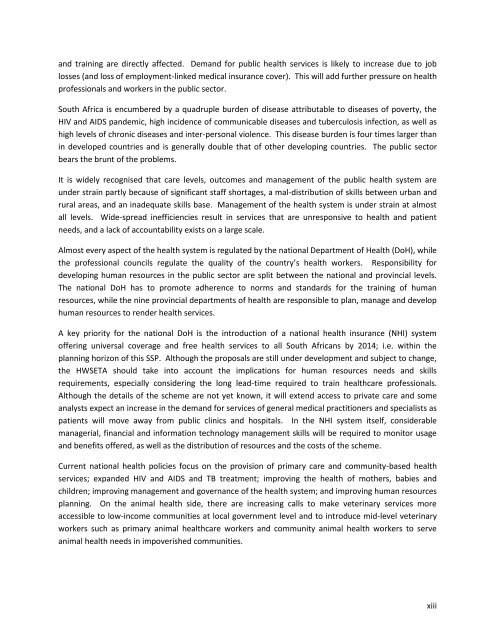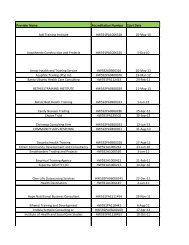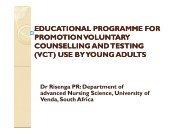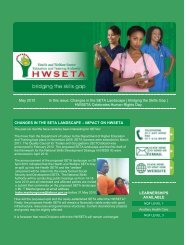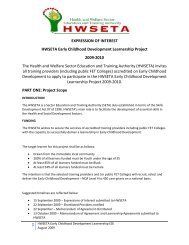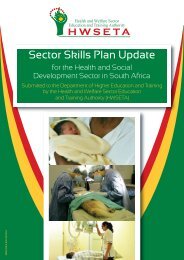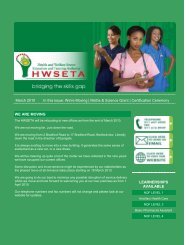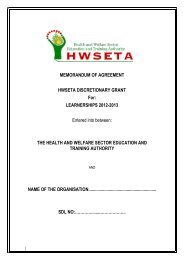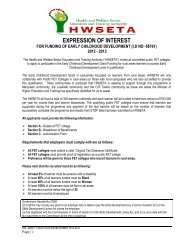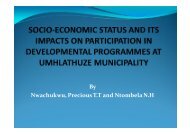sector skills plan for the health sector in south africa
sector skills plan for the health sector in south africa
sector skills plan for the health sector in south africa
You also want an ePaper? Increase the reach of your titles
YUMPU automatically turns print PDFs into web optimized ePapers that Google loves.
and tra<strong>in</strong><strong>in</strong>g are directly affected. Demand <strong>for</strong> public <strong>health</strong> services is likely to <strong>in</strong>crease due to job<br />
losses (and loss of employment-l<strong>in</strong>ked medical <strong>in</strong>surance cover). This will add fur<strong>the</strong>r pressure on <strong>health</strong><br />
professionals and workers <strong>in</strong> <strong>the</strong> public <strong>sector</strong>.<br />
South Africa is encumbered by a quadruple burden of disease attributable to diseases of poverty, <strong>the</strong><br />
HIV and AIDS pandemic, high <strong>in</strong>cidence of communicable diseases and tuberculosis <strong>in</strong>fection, as well as<br />
high levels of chronic diseases and <strong>in</strong>ter-personal violence. This disease burden is four times larger than<br />
<strong>in</strong> developed countries and is generally double that of o<strong>the</strong>r develop<strong>in</strong>g countries. The public <strong>sector</strong><br />
bears <strong>the</strong> brunt of <strong>the</strong> problems.<br />
It is widely recognised that care levels, outcomes and management of <strong>the</strong> public <strong>health</strong> system are<br />
under stra<strong>in</strong> partly because of significant staff shortages, a mal-distribution of <strong>skills</strong> between urban and<br />
rural areas, and an <strong>in</strong>adequate <strong>skills</strong> base. Management of <strong>the</strong> <strong>health</strong> system is under stra<strong>in</strong> at almost<br />
all levels. Wide-spread <strong>in</strong>efficiencies result <strong>in</strong> services that are unresponsive to <strong>health</strong> and patient<br />
needs, and a lack of accountability exists on a large scale.<br />
Almost every aspect of <strong>the</strong> <strong>health</strong> system is regulated by <strong>the</strong> national Department of Health (DoH), while<br />
<strong>the</strong> professional councils regulate <strong>the</strong> quality of <strong>the</strong> country’s <strong>health</strong> workers. Responsibility <strong>for</strong><br />
develop<strong>in</strong>g human resources <strong>in</strong> <strong>the</strong> public <strong>sector</strong> are split between <strong>the</strong> national and prov<strong>in</strong>cial levels.<br />
The national DoH has to promote adherence to norms and standards <strong>for</strong> <strong>the</strong> tra<strong>in</strong><strong>in</strong>g of human<br />
resources, while <strong>the</strong> n<strong>in</strong>e prov<strong>in</strong>cial departments of <strong>health</strong> are responsible to <strong>plan</strong>, manage and develop<br />
human resources to render <strong>health</strong> services.<br />
A key priority <strong>for</strong> <strong>the</strong> national DoH is <strong>the</strong> <strong>in</strong>troduction of a national <strong>health</strong> <strong>in</strong>surance (NHI) system<br />
offer<strong>in</strong>g universal coverage and free <strong>health</strong> services to all South Africans by 2014; i.e. with<strong>in</strong> <strong>the</strong><br />
<strong>plan</strong>n<strong>in</strong>g horizon of this SSP. Although <strong>the</strong> proposals are still under development and subject to change,<br />
<strong>the</strong> HWSETA should take <strong>in</strong>to account <strong>the</strong> implications <strong>for</strong> human resources needs and <strong>skills</strong><br />
requirements, especially consider<strong>in</strong>g <strong>the</strong> long lead-time required to tra<strong>in</strong> <strong>health</strong>care professionals.<br />
Although <strong>the</strong> details of <strong>the</strong> scheme are not yet known, it will extend access to private care and some<br />
analysts expect an <strong>in</strong>crease <strong>in</strong> <strong>the</strong> demand <strong>for</strong> services of general medical practitioners and specialists as<br />
patients will move away from public cl<strong>in</strong>ics and hospitals. In <strong>the</strong> NHI system itself, considerable<br />
managerial, f<strong>in</strong>ancial and <strong>in</strong><strong>for</strong>mation technology management <strong>skills</strong> will be required to monitor usage<br />
and benefits offered, as well as <strong>the</strong> distribution of resources and <strong>the</strong> costs of <strong>the</strong> scheme.<br />
Current national <strong>health</strong> policies focus on <strong>the</strong> provision of primary care and community-based <strong>health</strong><br />
services; expanded HIV and AIDS and TB treatment; improv<strong>in</strong>g <strong>the</strong> <strong>health</strong> of mo<strong>the</strong>rs, babies and<br />
children; improv<strong>in</strong>g management and governance of <strong>the</strong> <strong>health</strong> system; and improv<strong>in</strong>g human resources<br />
<strong>plan</strong>n<strong>in</strong>g. On <strong>the</strong> animal <strong>health</strong> side, <strong>the</strong>re are <strong>in</strong>creas<strong>in</strong>g calls to make veter<strong>in</strong>ary services more<br />
accessible to low-<strong>in</strong>come communities at local government level and to <strong>in</strong>troduce mid-level veter<strong>in</strong>ary<br />
workers such as primary animal <strong>health</strong>care workers and community animal <strong>health</strong> workers to serve<br />
animal <strong>health</strong> needs <strong>in</strong> impoverished communities.<br />
xiii


